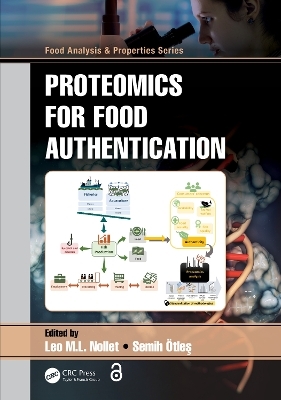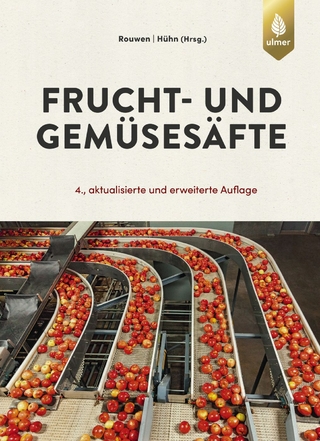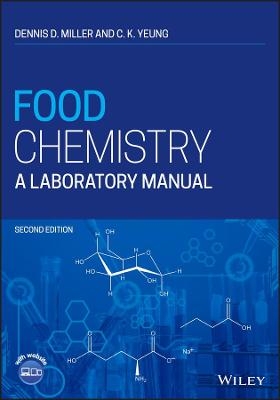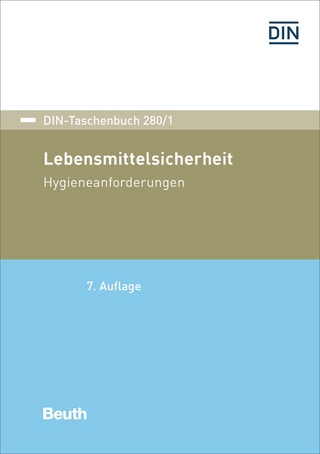
Proteomics for Food Authentication
CRC Press (Verlag)
978-0-367-20505-8 (ISBN)
Consumers have the right to know what is in the food they are eating, and accordingly, a number of global food regulations require that the provenance of the food can be guaranteed from farm to fork. Many different instrumental techniques have been proposed for food authentication. Although traditional methods are still being used, new approaches such as genomics, proteomics, and metabolomics are helping to complement existing methodologies for verifying the claims made about certain food products.
During the last decade, proteomics (the largescale analysis of proteins in a particular biological system at a particular time) has been applied to different research areas within food technology. Since proteins can be used as markers for many properties of a food, even indicating processes to which the food has been subjected, they can provide further evidence of the foods labeling claim. Proteomics for Food Authentication, a volume in the Food Analysis and Properties Series, is a comprehensive and updated overview of the applications, drawbacks, advantages, and challenges of proteomics for food authentication.
Features:
Provides a comprehensive and critical overview of the application of proteomics in food
Helps food scientists determine the authenticity of several food products
Provides applied techniques for both laboratory and industrial environments
Describes workflows, technologies, and tools that are being assessed in proteomics-related studies
Workflows, technologies, and tools that are being assessed in proteomics-related studies are described, followed by a review of the specific applications regarding food authenticity and, now and then, food quality.
The book will provide a comprehensive and critical overview of the application of proteomics approaches to determine the authenticity of several food products updating the performances and current limitations of the applied techniques in both laboratory and industrial environments. As such it is well suited to food scientist, chemical engineers, food engineers, research labs, universities, governments, related food industries.
Also available in the Food Analysis and Properties Series:
Food Aroma Evolution: During Food Processing, Cooking, and Aging, edited by
Matteo Bordiga and Leo M.L. Nollet (ISBN: 9781138338241)
Ambient Mass Spectroscopy Techniques in Food and the Environment, edited by Leo M.L. Nollet and Basil K. Munjanja (ISBN: 9781138505568)
Hyperspectral Imaging Analysis and Applications for Food Quality, edited by N.C. Basantia, Leo M.L. Nollet, and Mohammed Kamruzzaman (ISBN: 9781138630796)
For a complete list of books in this series, please visit our website at:
www.crcpress.com/Food-Analysis--Properties/book-series/CRCFOODANPRO
Leo M. L. Nollet earned an MS (1973) and a PhD (1978) in biology from the Katholieke Universiteit Leuven, Belgium. He is an editor and associate editor of numerous books. He edited for M. Dekker, New York—now CRC Press of Taylor & Francis Publishing Group—the first, second, and third editions of Food Analysis by HPLC and Handbook of Food Analysis. The last edition is a two-volume book. Dr Nollet also edited the Handbook of Water Analysis (first, second, and third editions) and Chromatographic Analysis of the Environment (third and fourth editions; CRC Press). With F. Toldrá, he coedited two books published in 2006, 2007, and 2017: Advanced Technologies for Meat Processing (CRC Press) and Advances in Food Diagnostics (Blackwell Publishing—now Wiley). With M. Poschl, he coedited the book Radionuclide Concentrations in Foods and the Environment, also published in 2006 (CRC Press). Dr Nollet has also coedited with Y. H. Hui and other colleagues on several books: Handbook of Food Product Manufacturing (Wiley, 2007), Handbook of Food Science, Technology, and Engineering (CRC Press, 2005), Food Biochemistry and Food Processing (first and second editions; Blackwell Publishing—now Wiley—2006 and 2012), and the Handbook of Fruits and Vegetable Flavors (Wiley, 2010). In addition, he edited the Handbook of Meat, Poultry, and Seafood Quality (first and second editions; Blackwell Publishing—now Wiley—2007 and 2012). From 2008 to 2011, he published five volumes on animal product–related books with F. Toldrá: Handbook of Muscle Foods Analysis, Handbook of Processed Meats and Poultry Analysis, Handbook of Seafood and Seafood Products Analysis, Handbook of Dairy Foods Analysis, and Handbook of Analysis of Edible Animal By-Products. Also, in 2011, with F. Toldrá, he coedited two volumes for CRC Press: Safety Analysis of Foods of Animal Origin and Sensory Analysis of Foods of Animal Origin. In 2012, they published the Handbook of Analysis of Active Compounds in Functional Foods. In a coedition with Hamir Rathore, Handbook of Pesticides: Methods of Pesticides Residues Analysis was marketed in 2009; Pesticides: Evaluation of Environmental Pollution in 2012; Biopesticides Handbook in 2015; and Green Pesticides Handbook: Essential Oils for Pest Control in 2017. Other finished book projects include Food Allergens: Analysis, Instrumentation, and Methods (with A. van Hengel; CRC Press, 2011) and Analysis of Endocrine Compounds in Food (Wiley-Blackwell, 2011). Dr Nollet’s recent projects include Proteomics in Foods with F. Toldrá (Springer, 2013) and Transformation Products of Emerging Contaminants in the Environment: Analysis, Processes, Occurrence, Effects, and Risks with D. Lambropoulou (Wiley, 2014). In the series Food Analysis & Properties, he edited (with C. Ruiz-Capillas) Flow Injection Analysis of Food Additives (CRC Press, 2015) and Marine Microorganisms: Extraction and Analysis of Bioactive Compounds (CRC Press, 2016). With A. S. Franca, he coedited Spectroscopic Methods in Food Analysis (CRC Press, 2017), and with Horacio Heinzen and Amadeo R. Fernandez-Alba, he coedited Multiresidue Methods for the Analysis of Pesticide Residues in Food (CRC Press, 2017). Further volumes in the series Food Analysis & Properties are Phenolic Compounds in Food: Characterization and Analysis (with Janet Alejandra Gutierrez-Uribe, 2018), Testing and Analysis of GMO-containing Foods and Feed (with Salah E. O. Mahgoub, 2018), Fingerprinting Techniques in Food Authentication and Traceability (with K. S. Siddiqi, 2018), Hyperspectral Imaging Analysis and Applications for Food Quality (with N. C. Basantia and Mohammed Kamruzzaman, 2018), Ambient Mass Spectroscopy Techniques in Food and the Environment (with Basil K. Munjanja, 2019), and Food Aroma Evolution: During Food Processing, Cooking, and Aging (with M. Bordiga, 2019). Semih Ötleş, a native of Izmir, Turkey, obtained his BSc degree from the Department of Food Engineering (Ege University) in 1980. During his assistantship at Ege University, in 1985, he received an MS in food chemistry, and in 1989, after completing his thesis research on the instrumental analysis and chemistry of vitamins in foods, he received a PhD in food chemistry from Ege University. In 1991–92, he completed his postdoctoral training on meat proteins including an OECD Postdoctoral Fellowship in the Research Center Melle at Gent University, Belgium. Afterward, he joined the Department of Food Engineering at Ege University as a scientist of Food Chemistry, being promoted to Associate Professor in 1993 and to Professor in 2000. He was Vice Dean of the engineering faculty (2003–2009), Head of the Department of Nutrition and Dietetics (2008–2011), and Vice Rector in Ege University (2012–2016). Professor Ötleş’s research activities have focused on instrumental methods of food analysis. Ötleş began a series of projects on separation and instrumental analysis techniques, first for the analysis of vitamins in foods, then protein chemistry, carbohydrates, and carotenoids, and most recently bioactive peptides. Other activities span the fields of GC, GC/MS, LC/MS/MS analysis, soy chemistry, aromatics, medical and functional foods, and nutraceutical chemistry. Included are multiresidue analysis of various foods, n-3 fatty acids in fish oils, and medical and functional foods.
Contents
Series Preface vii
Preface ix
Editors xi
Contributors xiii
SECTION I PROTEOMICS
Chapter 1 Review on Proteomics for Food Authentication 3
Ignacio Ortea, Gavin O’Connor, and Alain Maquet
SECTION II PEPTIDE-BASED APPROACHES
Chapter 2 1-DE and 2-DE: In-Gel Tryptic Digestion 39
Semih Ötleş and Vasfiye Hazal Özyurt
Chapter 3 Non-Directed Analysis 49
Dev Kant Shandilya
Chapter 4 Targeted Proteomics for Food Authentication 61
Devarajan Thangadurai, Mojtaba Kordrostami, Saher Islam,
Arun Kashivishwanath Shettar, Jeyabalan Sangeetha, Mohammad
Mafakheri, Jasmin Habeeb, Abdel Rahman Mohammad Said
Al-Tawaha, Steffi Simmi Maxim, and Ravichandra Hospet
Chapter 5 A MALDI-TOF-MS Approach for Mammalian, Human, and
Formula Milk Profiling 79
Laura Di Francesco, Francesco Di Girolamo, Maurizio Mennini,
Andrea Masotti, Guglielmo Salvatori, Giuliano Rigon, Fabrizio
Signore, Emanuela Pietrantoni, Margherita Scapaticci, Isabella
Lante, Bianca Maria Goffredo, Oscar Mazzina, Ahmed Ibrahim
Elbousify, Paola Roncada, Andrea Dotta, Alessandro Fiocchi, and
Lorenza Putignani
Chapter 6 MALDI-TOF-MS Analysis of Foods 95
Leo M.L. Nollet
SECTION III PROTEIN-BASED APPROACHES
Chapter 7 Whole Protein Analysis Using LC-MS/MS for
Food Authentication 105
Jeyabalan Sangeetha, Arun Kashivishwanath Shettar, Devarajan
Thangadurai, Chethan Jambanna Dandin, Ravichandra Hospet,
Bhavisha Prakashbhai Sheth, Saher Islam, Abdel Rahman
Mohammad Said Al-Tawaha, Mojtaba Kordrostami, and
Mohammad Mafakheri
SECTION IV PROTEOMICS AND FOOD AUTHENTICITY
Chapter 8 Proteomic Authentication of Dairy Products 123
Saher Islam and Devarajan Thangadurai
Chapter 9 Proteomic Tools for Improved Processing of Dry-Cured Meats 153
Leticia Mora and Fidel Toldrá
Chapter 10 Fish 177
Marco Alexandre Cavaco Cerqueira, Ana Paula Farinha,
Denise Schrama, Márcio Júlio Vicente Moreira, Cláudia Sofia
Ferreira Raposo de Magalhães, and Pedro Miguel Leal Rodrigues
Chapter 11 Proteomics in Authentication of Wine 203
Javed Ahamad, Javed Ahmad, Showkat R. Mir, and
Raad A. Kaskoos
Chapter 12 Proteomics in Authentication of Honey 213
Javed Ahamad, Javed Ahmad, Muath Sh. Mohammed Ameen,
Esra T. Anwer, Showkat R. Mir, and Ameeduzzafar
Chapter 13 GMOs 229
Rajesh Kumar
Index 245
| Erscheinungsdatum | 01.06.2020 |
|---|---|
| Reihe/Serie | Food Analysis & Properties |
| Zusatzinfo | 19 Tables, black and white; 39 Illustrations, black and white |
| Verlagsort | London |
| Sprache | englisch |
| Maße | 178 x 254 mm |
| Gewicht | 648 g |
| Themenwelt | Technik ► Lebensmitteltechnologie |
| ISBN-10 | 0-367-20505-X / 036720505X |
| ISBN-13 | 978-0-367-20505-8 / 9780367205058 |
| Zustand | Neuware |
| Haben Sie eine Frage zum Produkt? |
aus dem Bereich


